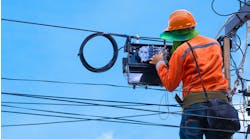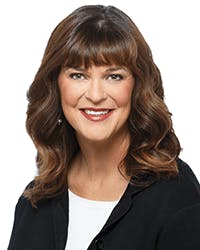Meet Ann Shaub, Network Deployment and Operations Lead, Google Fiber —
This Q&A series focuses on women in the ICT/telecom industry who are moving the needle across the business while they charge ahead to make our industry more inclusive and diverse. Look for more Science, Technology, Engineering, and Mathematics (STEM) interviews in upcoming issues. And why not nominate someone you know who is making a difference on many levels? Email your editor with ideas: [email protected].
ISE magazine / Sharon Vollman: Please share with us what you do at Google and why it’s important.
Ann Shaub / Google Fiber: I am part of the Google Fiber team! My slice of the pie is to focus on bringing super-fast Internet, phone, and video services to consumers and small businesses in Atlanta, Ga. I have spent my entire career in the telecom industry, and what is so exciting, and why I came to Google, is that we are building a network that will meet both the needs of our subscribers not only today, but also in the future, at a competitive price.
ISE: How did you get involved in a STEM career?
Shaub: I am incredibly lucky to have parents who influenced me in so many ways. My mom is an incredibly strong and talented woman. She was an elementary school teacher until just before I was born. So, while I didn’t see her in the classroom, I benefited from her many techniques to help us learn. While I was growing up, my mom led the church choir and sang in a band. She showed me how you can manage your family plus succeed outside the home. My dad is a mathematician. He had an amazing career at the Applied Physics Lab at Johns Hopkins University. I’ll never forget him bringing home the phone coupler that allowed him to dial into the mainframe computer from home. I was mesmerized! I guess it’s no surprise that I ended up studying Mathematics, with a focus on Actuarial Science, when I went to college. I wasn’t afraid of the numbers (Thanks, Dad!) and I wasn’t afraid of learning something new (Thanks, Mom!). Upon graduation, I accepted a role at C&P Telephone Company (now Verizon) as a Central Office Engineer. Once at the phone company, I had amazing opportunities to design networks, develop new products and services using new technologies, and engineer solutions for large customers based on network technologies deployed. And now, at Google, I have an opportunity, yet again, to work with technology to bring products and services to subscribers in a way that simplifies their lives and allows them to stay connected.
ISE: What has been the secret to your success?
Shaub: The secret to my success is all about dreaming big and not being afraid to either succeed or fail! I am a big believer that nothing in this life is random, and when things don’t go as planned, we need to learn from that and adjust. I also believe that you have to share your talents with others, and so mentoring and working with others is near and dear to me. In the end, you need to believe in your dream, believe in yourself, and trust that you understand the path to success — both what it is and how you achieve it.
ISE: Share the biggest obstacle your company faced recently and how your team solved it successfully.
Shaub: When building a fiber network, a major challenge is the time it takes to construct the network and make the service available to subscribers. At Google Fiber, we continue to explore new deployment models and technologies that make it faster and more efficient to connect people to super-fast Internet. These techniques allow us to more quickly build our network with much less disruption to residents.
ISE: What are the most challenging issues our industry must address in 2018?
Shaub: I think the biggest challenge for our industry is with the consumer’s insatiable need to be connected, whether at home or away, and how we build networks that allow them to stay connected. In just the last decade, we have moved from a home Internet experience where we did basic search over connections measured in kbps, to today where Google is now a verb for search, online shopping is an everyday experience, and access to both real time and long tail content are equally available — over home Internet connections measured in Mbps or Gbps.
Our homes are becoming smarter and more energy efficient, thanks to smart thermostats and cameras that are generally readily available. And our connected devices in the home continue to proliferate. We are a long way from those days of one desktop computer in the home office. We now have laptops, tablets, smartphones, smart TVs, game consoles — all capable of connecting to the Internet to send and receive content and information. And while our homes are connected, our desire to cut the cords to our house continue. We now have smartphones which allow us to make and receive calls, message friends, engage in social media, search the Internet, stream videos, play games, and check on the security of our homes — all while away from home.
Just as the bandwidth in the home has increased, so has the bandwidth "in the air", which allows a network that a decade ago carried voice and simple text messaging to now carry a wide array of high bandwidth content. And so, as an industry, we must continue to innovate on ways to meet the increasing wireline and wireless bandwidth demands, and allow the consumer to stay connected, with the peace of mind that their information and content is safe and secure.
ISE: "Technology players need to think more innovatively about increasing diversity within their organizations and attracting women to roles that are still dominated by men," said Mats Granryd, the Director General of the GSM Association (GSMA) at this year’s Mobile World Congress (MWC). Granryd argued the industry could be foregoing billions of dollars in profits because of the shortage of women in senior roles. A report from the Peterson Institute, a research company, supports that position by saying there is a strong correlation between gender diversity and profitability. What is the answer to this challenge and what is Google doing in this area?
Shaub: At Google, diversity is a natural extension of our core mission: to increase access to information and opportunity by breaking down barriers through technology. We focus on enhancing and celebrating diversity within Google, while also working to increase opportunities to participate in and contribute to technology more broadly. This is a long-term commitment that means not just hiring for diverse perspectives and backgrounds, but also helping ensure more people have access to the Internet and the tools and skills to take advantage of its opportunities.
ISE: What project would you consider your most significant career accomplishment to date?
Shaub: I have often said, "It all started with the dogs." In 4 short years, an idea that started out as a simple way to keep an eye on the new puppy at home, the puppy cam, evolved to an entire home monitoring and control suite of services with interface points on the smartphone, computer and TV. My role in leading and launching a Connected Home product at Verizon is the project that I consider to be my most significant career accomplishment to date. It wasn’t just leading the core team that was developing the platform, evaluating all aspects of the user experience, and negotiating with device manufacturers that was so exciting (although it absolutely was!), it was also the role I played in taking our story to the industry — speaking at conferences, influencing emerging technologies like Z-Wave, and collaborating with new partners to bring the dream to life! While the vision of the Connected Home — now the Smart Home — has continued to evolve at both Verizon and within the industry, I am incredibly proud of my contribution to the path the industry is taking to bring peace of mind to consumers when they are at home or away.
ISE: How do you go about continuing to develop your professional skills and knowledge?
Shaub: I believe strongly in the value of networking. I find the art of conversation the best way for me to learn and grow. And so, I seek out those who know things I want to know, and listen to everything they can tell me. It is always an added bonus when they can show me what they do — particularly with regards to technology advancements. While I am audible, I much prefer the visual aspects of learning.
ISE: Some say technology can become a "shiny object" unless it’s properly focused to solve needs that matter. How do we make sure we are focusing on the right things and not just shiny objects?
Shaub: Those that know me know that I love the process of documenting the "Big Rules": what problem are we solving for, who are the key stakeholders, why is this important now, when do we need to solve our problem, and how do you get from here to there. It is incredibly easy to get lost in the journey of discovery, and so having a map that you follow keeps you on the right path. I think it is also important to understand exactly what success means, and how you can iterate on a solution that allows you to systematically achieve success, even with staged deliverables over time.
ISE: What’s the best piece of advice you can give to anyone aiming to succeed in the ICT industry?
Shaub: The best piece of advice that I can give someone aiming to succeed in the ICT industry is to understand how what you are doing contributes to the overall information and communications ecosystem. We are part of an industry that is advancing and morphing at a rapid pace, and if you aren’t keeping your eye on those movements, you may find yourself left behind. Take a moment every day to look up and look out to see how the world around you is moving, and you will be better prepared to make the necessary adjustments to your initiatives as you go along.
ISE: What is a motto or quote that motivates you?
Shaub: Life begins at the end of your comfort zone about sums it up! Taking that next step just outside my comfort zone is what motivates me every day. It is both frightening and exhilarating, and I wouldn’t have it any other way!






